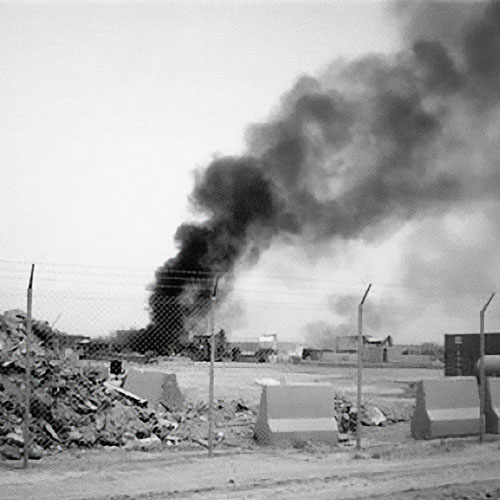The energy experts at Fort Knox have proven their mettle by creating an installation capable of self-sufficiency that will reap benefits for decades.
Our Golden Secret in Fort Knox
Mention Fort Knox and most people think of the massive mountain of gold stored in the United States Bullion Depository. The Kentucky outpost does indeed hold a chunk of the federal treasury’s precious metal, which recently amounted to 147.3 million ounces. But one could argue Fort Knox’s real riches reside in the nearby military installation of the same name that has become a model of energy resiliency and efficiency as it has the ability to run indefinitely off the grid.
The journey to such sustainability has taken more than 20 years and counting — along with some trial and error. It also followed decades of solely receiving natural gas and coal-fueled electrical power from Louisville Gas & Electric (LG&E).
A wind turbine project was tested at Knox in the 1990s, but the state’s lack of consistent wind meant that option was lost on the breeze. That was followed up with a solar array of about 10,000 panels established on 10 acres of land. The array is still in use today, but due to the area’s temperate weather, its output fluctuates. Knox’s energy program manager R.J. Dyrdek says the array can produce about 2.1 megawatts of power. But the installation’s needs are far greater.
Next, the energy crew turned their attention to Kentucky’s underground caves to harness geothermal technology to utilize the Earth’s natural temperatures for heating and cooling.
“The idea is that the ground below 48 inches deep is roughly 55 degrees all year,” says Jason Root, director of the Fort Knox Directorate of Public Works. “In the summertime, 55 degrees is great because you can use that temperature to help absorb air-conditioning heat from the cooling process in the summer. In the winter, 55 degrees helps as you attempt to cool the soil further, having the heat generated in the air conditioning process sent to the building to heat it. This is done via deep wells and sealed water piping called ground source heat pumps.”
This effort has proven successful with at least 250 facilities using it. Additionally, Knox has established well fields to circulate water for most of the base’s buildings.
“It’s about three times as efficient as buying an electric heater and standard air conditioner at your house,” Dyrdek explains. “It saves us money and can pay back the added expense of pipes and wells in under eight years.”
However, that system showed its limitations in 2009 when an ice storm affected the outside utility power lines connected to the base.
“We didn’t have power for 10 days,” Dyrdek recalls.
That meant there was also no heat or water, and Dyrdek acknowledges, “That quickly became way more important than just no lights.”
Root adds, “That ice storm forced us into a completely new way of understanding energy and approaching resilience and security.”
The team then eyed a system of decentralized power generation, which ultimately carried a $62 million price tag. Natural gas deposits below Fort Knox were tapped as a source of electricity-spinning fuel, which would eliminate Knox’s reliance on local utilities and result in less of an environmental impact than diesel or coal.
Starting in 2010, multiple 700-foot-deep wells were drilled to capture biogenic methane discovered at the edge of the base. Not all of them remain open today, but 20 are still useable and some are in full production.
Just over a decade ago, Knox’s energy team also received permission to purchase and directly access natural gas from a nearby transcontinental pipeline.
Fuel from the two sources is sent to a compressor site that purifies the gas from the Knox-run wells and combines it with the purchased pipeline gas. That is then sent to six on-post substations to provide the majority of Knox’s power grid needs.
Despite the upfront costs, Dyrdek says the investment has continued to pay off. While Knox still does use some electricity from LG&E, he points out that in July 2015 alone, the generators saved the base more than $400,000!
A large chunk of that savings is chalked up to the system’s automated central control hub, which can ramp up more of Fort Knox’s own power to answer increasing demand — and provide Knox with the ability purchase lower-cost electricity in off-peak hours from LG&E.
If needed, Knox can even continue to operate if its power is cut from the outside. In late 2022, the utility company had to briefly shut power to the base — but Knox was able to have their own system fully functional within 90 minutes.
Knox’s gas-powered plan is also being praised for having less of a carbon footprint than coal-fired systems. As natural gas is extracted, heat is captured at a generator and sent to an absorption chiller. That equipment transforms the excess heat into cooling energy for distribution — instead of it being ejected into the environment. For Knox, that adds up to 600 tons of air-conditioning at no added cost!
“The absorption chiller pumps all this free heat into the bottom of this pressure cooker, and that lithium bromide changes phase. It goes from a gas to a liquid. It absorbs a massive amount of heat, so the water in that same pressure cooker turns cold,” Dyrdek says. “You make chilled water from heat.”
Now, the Department of Defense is studying Knox’s efforts to determine if they’re scalable at other installations. But Fort Knox’s staff is not done striving for improvement.
Funded by part of a Department of Energy grant, the base is designing and purchasing an electrochemical fuel cell and battery storage in a bid to use natural gas to produce more environmentally friendly electricity.
Root says, “These fuel cells, even though they’re using natural gas, it has 50 percent less carbon dioxide emissions just by the way it processes.”
The total effort is still a work in progress. However, Root explains, “It takes time to move things through a legislative process, a design process, a construction process, an implementation process. “Our job is to take as many steps as we can, hand the baton to somebody else, and then let them continue moving that forward.”
Dyrdek has expressed hope that the future may one day include benefits that extend beyond the base.
“Currently, the military can’t put power back into a community, so we don’t want to have too much,” says Dyrdek. “If they get some of the legislative and regulatory issues resolved, we could help the community when they need power, or we could run by ourselves when they don’t need to supply us.
“There are big solutions if we can technologically make the fuel cells work. Then we could potentially be even better partners to our community.”
Since the “Gold Standard” disappeared officially over fifty years ago in 1971, when the U.S. would no longer trade paper dollars for gold upon request, we do find it heartening to hear that Fort Knox has not lost its relevance. Indeed, ol’ Knox may be playing an even important role these days. Should you be one of those admirable people who enjoys seeing what America has to offer, a trip to Kentucky could fit into your schedule. Of course while the military history in the area might be fascinating to some among us, if you’re going to go all the way to Kentucky, you really should try the bourbon. Just sayin’…




















